
The Airview Historic District is a district of 12 houses built between 1896 and 1930 on each side of East Main Street in Middletown, Maryland. The district was developed to take advantage of the Hagerstown and Frederick Railway, which paralleled what was then known as the National Pike, and is an example of a small-scale streetcar suburb. The subdivision was subdivided from the Kefauver farm and included a trolley stop in front of developer Lewis Kefauver's house. The trolley right-of-way is still visible in the deep setback between the street and the sidewalk in the front yards of houses on the north side of the street.
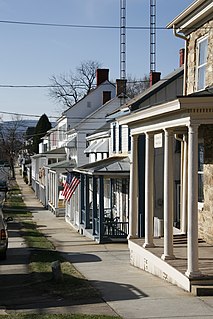
The Middletown Historic District comprises the historic center of Middletown, Maryland. Middletown became the chief community in the Middletown Valley in the late 18th century, retaining its importance until the 1930s, when the expanding influence of Frederick, Maryland, the construction of a bypass on US 40 and the abandonment of the Hagerstown and Frederick Railway produced a gradual decline. The historic district preserves many mid-19th-century buildings in the central downtown area. To the east, the district includes early 20th-century houses built along the trolley right-of-way, forming a streetcar suburb. The Airview Historic District includes a related area of early 20th century development to the east of town along the National Pike, separated from the main district by a section of newer development.
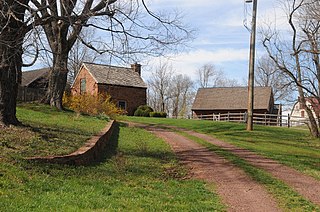
Darnall Place is a historic farm complex located at Poolesville, Montgomery County, Maryland, United States. The farm complex consists of four small 18th-century stone buildings, a 19th-century frame wagon shed/corn crib, a 20th-century concrete block barn, and three late-19th- or early-20th-century frame sheds. The stone buildings are all constructed of red-brown Seneca sandstone. The one-story dwelling has a large external stone chimney on the east end. The farmstead is reminiscent of those in Europe or the British Isles.

Cherry Grove, located on property formerly called Fredericksburg, 400 acres patented by Orlando Griffith's oldest son Henry Griffith in 1750. Cherry Grove is a historic home and former forced-labor farm located at Woodbine, Howard County, Maryland, United States. The home is considered the seat of the Warfield family of Maryland.

The Curtis—Shipley Farmstead is a historic home located at Ellicott City, Howard County, Maryland, United States. It is located on the first land grant in modern Howard County, then Anne Arundel County, to the English settler Adam Shipley in 1688 who settled properties in Maryland as early as 1675. The 500-acre estate was called "Adam the First".
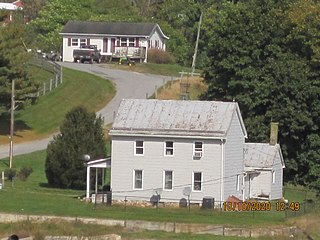
The Drummine Farm is a historic home and farm complex located at New Market, Frederick County, Maryland, United States. The main house was constructed about 1790 and is a 2+1⁄2-story structure of uncoursed fieldstone. The house retains Georgian stylistic influences in exterior and interior decorative detailing. The farm complex structures include a stone tenant house dated 1816, and four additional fieldstone buildings from the early 19th century: a smokehouse, a water storage house, a garden outhouse, and a large bank barn. Wooden farm buildings include a calf shed and a wagon shed with corn cribs from the late 19th century, a dairy barn with three cement stave silos from the 1930s, several sheds and garages, and a large pole barn.
The Henry Nelson House is a historic home and farm complex located at New Market, Frederick County, Maryland, United States. It is a 2+1⁄2-story, coursed stone rubble house built about 1800, with a gable roof, and a corbeled brick cornice. Outbuildings include a barn, log springhouse, and a small log house.

The Routzahn-Miller Farmstead is a historic home and farm complex located at Middletown, Frederick County, Maryland, United States. It consists of a Federal style-influenced brick house and smokehouse, both built about 1825; a later frame out-kitchen / washhouse; a standard Pennsylvania barn; a 20th-century dairy barn and milk house; and a 20th-century equipment shed. The Pennsylvania barn was probably built in the late 19th century and was recently rehabilitated for use as a preschool. The complex is located on a 16.7-acre (68,000 m2) parcel on the east flank of South Mountain. It is representative example of a type of domestic and agricultural grouping which characterized the rural mid-Maryland region from the early 19th century through World War II era.
The Daniel Sheffer Farm is a historic home and farm complex located at Middletown, Frederick County, Maryland, United States. It is dominated by the two story brick main house, which was constructed between 1840 and 1850. Outbuildings include a stone spring house, a large wood-frame barn, constructed about 1900, and several wood-frame outbuildings including a corncrib, a wagon shed, three frame wood sheds, two tractor sheds, and a chicken house. A concrete block milk house and terra cotta silo were added to the complex in the 1930s. In September 1862, the property served as a temporary hospital for wounded soldiers during the Battle of South Mountain in the American Civil War.

The George Markell Farmstead, also known as Arcadian Dairy Farm and the Thomas Property, is a historic home and farm complex located at Frederick, Frederick County, Maryland, United States. It consists of brick house built about 1865, a brick smokehouse, a bake oven, two stone domestic outbuildings, an ice house, a springhouse, a frame stable, a frame chicken house, a mid-20th century guest house, and various sheds and outbuildings. Nearby is a large gambrel-roofed concrete block barn. The main house has combined Greek Revival and Italianate stylistic influences. The once large Markell dairy farm, with its lane to the Ballenger Creek ford of the Monocacy River, served as the primary approach route to the battlefield by Confederate troops during the July 9, 1864 Battle of Monocacy during the American Civil War.
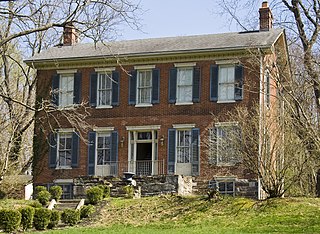
The Linganore Farm is a historic home and farm complex located at Frederick, Frederick County, Maryland, United States. The main house is a large two-story brick dwelling dating from the 1850s-60s and showing influence of the Greek Revival and Italianate styles. The property includes the ruins of a brick smokehouse, a stone root cellar and a two-story brick secondary house dating from the early 19th century. Across from the house is the site of the Linganore Mill, which was located on the east bank of the Monocacy River. In front of the house is a terraced lawn defined with large boxwoods. In 1891, the farm was converted to a resort known as the Linganore Hills Inn.

The John Eyler Farmstead is a historic home and farm complex located at Thurmont, Frederick County, Maryland, United States. It includes a two-story, side-passage Flemish bond brick farmhouse with a rear wing built about 1820, a stone springhouse ruin, and a brick silo.
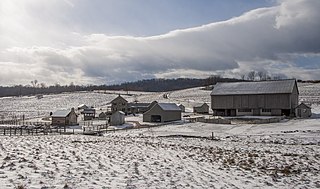
Peter of P. Grossnickel Farm is a historic home and farm complex located at Myersville, Maryland, Frederick County. It consists of a mid-19th-century, Greek Revival farmhouse and 13 related buildings and structures. The house is a 2+1⁄2-story stone center-passage house on a limestone foundation, with a 1+1⁄2-story kitchen wing and 18-inch-thick (460 mm) walls. The house was built between 1840 and 1850. Also on the property is an 1881 tenant house with corresponding barn, spring house, and washhouse / privy; an 1884–1897 bank barn; a pre-1830 granary; a 19th-century wood shed; late-19th-century hog pen / chicken house; a pre-1830 beehive oven; a late-19th-century smokehouse; a spring house with a Late Victorian cottage addition; and early-20th-century concrete block milk house; and a log summer kitchen of unknown date. The Grossnickel family was a German American family who were instrumental in the establishment of the Grossnickel Church of the Brethren.

Harris Farm is a historic home and farm complex located at Walkersville, Frederick County, Maryland, United States. The main house was built in 1855, and is a three-story center plan house in predominantly late Greek Revival syle, with some Italianate elements. The agricultural complex consists of a bank barn with an attached granary; a second frame barn that shares an animal yard with the bank barn; a row of frame outbuildings including a converted garage, a workshop, and a chicken house. There is also a drive-through double corn crib; and a frame pig pen from 1914. The 20th-century buildings consist of a frame poultry house, a dairy barn with milk house and two silos, and an octagonal chicken coop. A lime kiln is located on the edge of the property. The property is preserved as part of the Walkersville Heritage Farm Park.
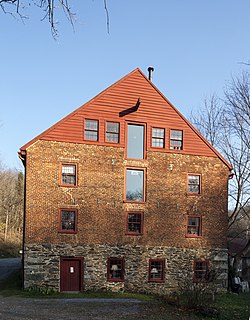
Lewis Mill Complex is a historic grist mill complex located at Jefferson, Frederick County, Maryland. The complex consists of seven standing structures, a house foundation, and the remains of an earlier millrace. It centers on an early 19th-century three-story brick mill structure with a gabled roof. The mill complex served German immigrant farmers in Middletown Valley between 1810 and the 1920s. It was rehabilitated in 1979-1980 for use as a pottery shop. Also in the complex are a stuccoed log house and log springhouse built about; a frame wagon shed and corn crib structure and frame barn dating from the late 19th century; and early 20th century cattle shelter and a frame garage.
Nicodemus Mill Complex is a historic home and mill complex located at Keedysville, Washington County, Maryland, United States. It consists of a dated 1810 2+1⁄2-story, five-bay stone house with a mid-19th-century brick service wing, the ruins of a grist mill built about 1829, and an extensive complement of 19th-century domestic and agricultural outbuildings including a stone springhouse, stone-end bank barn, brick out kitchen, frame wash house, and a stuccoed stone secondary dwelling. It is an intact representative example of the type of farmstead characteristic of the region during the 19th century.
The William and Catherine Biggs Farm is a historic home and farm complex located at Detour, Carroll County, Maryland, United States. The complex consists of a stone house, a stone outbuilding / summer kitchen, a frame bank barn, and an early-20th-century concrete block barn, dairy building, and silo. The house is a two-story, five-by-two-bay structure with a three-by-two-bay, two-story rear wing. It is built primarily of rubble stone.

The Bennett-Kelly Farm is an historic home and farm complex located at Sykesville, Carroll County, Maryland, United States. The complex consists of a stone and frame house, a stone mounting block, a stone smokehouse, a frame bank barn, a frame wagon shed, a frame chicken house, a concrete block dairy or tool shed, and a stone spring house. The original mid-19th century stone section of the house is three bays wide and two stories high. The house features a one-bay Greek Revival pedimented portico with Doric columns. It is an example of a type of family farmstead that characterized rural agricultural Carroll County from the mid 19th century through the early 20th century.

Lehman's Mill Historic District is a national historic district at Hagerstown, Washington County, Maryland, United States. The district comprises the remaining buildings of the mill group including the brick Lehman's Mill, built in 1869 for Henry F. Lehman, the farmstead with a stuccoed stone house dated 1837 with older and newer sections, a barn, carriage house, and agricultural outbuildings; another dwelling, also built by Lehman in 1877, a two-story brick and frame house; related outbuildings, and a portion of the mill's head and tail race. It is the oldest continuously operating mill in Washington County, and is the most intact mill complex remaining in the county.
Long Island Farm is a historic farmstead at 2200 Cromwell Bridge Road in Parkville, Maryland. The main house is a rambling multi-part building whose oldest part is said to date to 1764, when Isaac Risteau purchased the property. The main eastern block of the house is built of stone and is five bays wide, but shows evidence that it once consisted of several separate sections that were built separately and then combined. The western block is a modern 20th century addition. The farmstead was associated with the Risteau and Jenifer families for over two centuries.


















